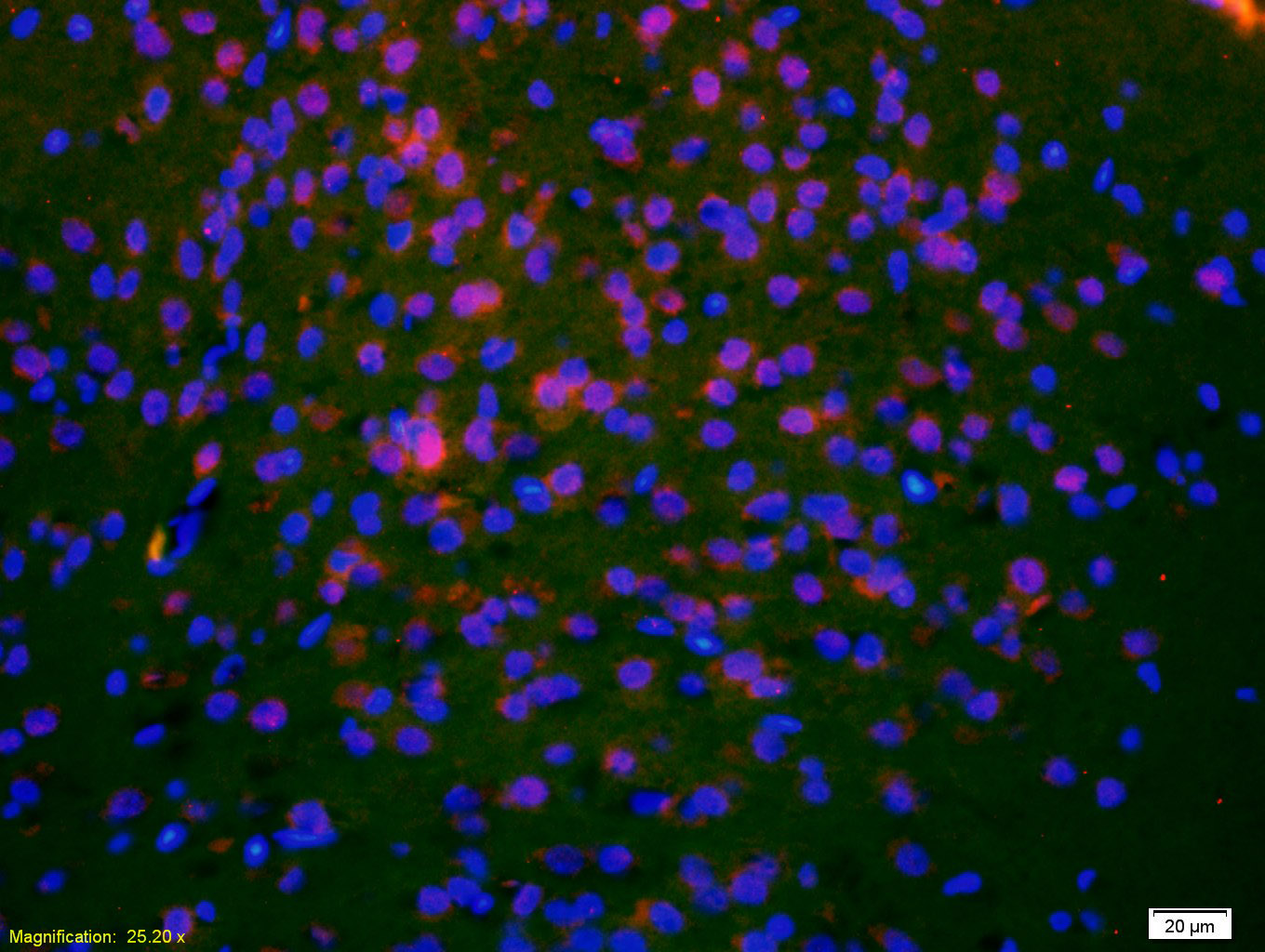
Rabbit Anti-DCLREC1C antibody
A SCID; A SCID protein; Artemis protein; ASCID; DCLRE1C; DCLRE1C DNA cross link repair 1C; DCLRE1C protein; DCLREC1C; DCLREC1C; DCR1C_HUMAN; DNA cross link repair 1C; DNA cross link repair 1C protein; DNA cross-link repair 1C protein; FLJ11360; FLJ11360;
View History [Clear]
Details
Product Name DCLREC1C Chinese Name DNA交联修复蛋白1C抗体 Alias A SCID; A SCID protein; Artemis protein; ASCID; DCLRE1C; DCLRE1C DNA cross link repair 1C; DCLRE1C protein; DCLREC1C; DCLREC1C; DCR1C_HUMAN; DNA cross link repair 1C; DNA cross link repair 1C protein; DNA cross-link repair 1C protein; FLJ11360; FLJ11360; FLJ36438; hSNM1C; OTTHUMP00000045150; Protein A-SCID; Protein ARTEMIS; PSO2 homolog; RS SCID; SCIDA; SCIDA; Severe combined immunodeficiency type a; SNM1 homolog C; SNM1 like protein; SNM1-like protein; SNM1C; SNM1C. Research Area Cell biology Epigenetics Immunogen Species Rabbit Clonality Polyclonal React Species Rat, (predicted: Human, Mouse, Cow, Horse, ) Applications WB=1:500-2000 ELISA=1:5000-10000
not yet tested in other applications.
optimal dilutions/concentrations should be determined by the end user.Theoretical molecular weight 78kDa Cellular localization The nucleus Form Liquid Concentration 1mg/ml immunogen KLH conjugated synthetic peptide derived from human DCLREC1C/Artemis: 301-400/692 Lsotype IgG Purification affinity purified by Protein A Buffer Solution 0.01M TBS(pH7.4) with 1% BSA, 0.03% Proclin300 and 50% Glycerol. Storage Shipped at 4℃. Store at -20 °C for one year. Avoid repeated freeze/thaw cycles. Attention This product as supplied is intended for research use only, not for use in human, therapeutic or diagnostic applications. PubMed PubMed Product Detail Distinct DNA repair pathways minimize the consequences of mutagenic events. Reactive oxygen species (ROS) are highly reactive atoms with an unpaired electron that are conducive to double-strand DNA breaking events. Artemis, named after the Greek goddess for the protection of children, is one of the major proteins contributing to the preservation of double-strand breaks in DNA by cutting away the damaged parts of the DNA, which allows the strands to rejoin. Artemis is a single-strand-specific 5' to 3' exonuclease that forms a complex with the DNA-dependent protein kinase (DNA-PKcs). DNA-PKcs phosphorylates Artemis, and Artemis acquires endonucleolytic activity on 5' and 3' overhangs and hairpins. These activities are essential for V(D)J recombination and for the 5' and 3' overhang processing in nonhomologous DNA end joining. Mutations in the human Artemis protein result in hypersensitivity to DNA double-strand break-inducing agents and absence of B and T lymphocytes, which is known as "bubble boy" disease or severe combined immunodeficiency disease (SCID). The human Artemis gene maps to chromosome 10p13, and encodes a 577 amino acid protein.
Function:
Required for V(D)J recombination, the process by which exons encoding the antigen-binding domains of immunoglobulins and T-cell receptor proteins are assembled from individual V, (D), and J gene segments. V(D)J recombination is initiated by the lymphoid specific RAG endonuclease complex, which generates site specific DNA double strand breaks (DSBs). These DSBs present two types of DNA end structures: hairpin sealed coding ends and phosphorylated blunt signal ends. These ends are independently repaired by the non homologous end joining (NHEJ) pathway to form coding and signal joints respectively. This protein exhibits single-strand specific 5'-3' exonuclease activity in isolation and acquires endonucleolytic activity on 5' and 3' hairpins and overhangs when in a complex with PRKDC. The latter activity is required specifically for the resolution of closed hairpins prior to the formation of the coding joint. May also be required for the repair of complex DSBs induced by ionizing radiation, which require substantial end-processing prior to religation by NHEJ.
Subcellular Location:
Nucleus.
Tissue Specificity:
Ubiquitously expressed, with highest levels in the kidney, lung, pancreas and placenta (at the mRNA level). Expression is not increased in thymus or bone marrow, sites of V(D)J recombination.
Post-translational modifications:
Phosphorylation on undefined residues by PRKDC may stimulate endonucleolytic activity on 5' and 3' hairpins and overhangs. PRKDC must remain present, even after phosphorylation, for efficient hairpin opening. Also phosphorylated by ATM in response to ionizing radiation (IR) and by ATR in response to ultraviolet (UV) radiation.
DISEASE:
Defects in DCLRE1C are a cause of severe combined immunodeficiency autosomal recessive T-cell-negative/B-cell-negative/NK-cell-positive with sensitivity to ionizing radiation (RSSCID) [MIM:602450]. SCID refers to a genetically and clinically heterogeneous group of rare congenital disorders characterized by impairment of both humoral and cell-mediated immunity, leukopenia, and low or absent antibody levels. Patients with SCID present in infancy with recurrent, persistent infections by opportunistic organisms. The common characteristic of all types of SCID is absence of T-cell-mediated cellular immunity due to a defect in T-cell development. Individuals affected by RS-SCID show defects in the DNA repair machinery necessary for coding joint formation and the completion of V(D)J recombination. A subset of cells from such patients show increased radiosensitivity.
Defects in DCLRE1C are the cause of severe combined immunodeficiency Athabaskan type (SCIDA) [MIM:602450]. SCIDA is a variety of RS-SCID caused by a founder mutation in Athabascan-speaking native Americans, being inherited as an autosomal recessive trait with an estimated gene frequency of 2.1% in the Navajo population. Affected individuals exhibit clinical symptoms and defects in DNA repair comparable to those seen in RS-SCID.
Defects in DCLRE1C are a cause of Omenn syndrome (OS) [MIM:603554]. OS is characterized by severe combined immunodeficiency associated with erythrodermia, hepatosplenomegaly, lymphadenopathy and alopecia. Affected individuals have elevated T-lymphocyte counts with a restricted T-cell receptor (TCR) repertoire. They also generally lack B-lymphocytes, but have normal natural killer (NK) cell function (T+ B- NK+).
Similarity:
Belongs to the DNA repair metallo-beta-lactamase (DRMBL) family.
SWISS:
Q96SD1
Gene ID:
64421
Database links:Entrez Gene: 64421 Human
Omim: 605988 Human
SwissProt: Q96SD1 Human
Unigene: 656065 Human
Product Picture
Antigen retrieval: citrate buffer ( 0.01M, pH 6.0 ), Boiling bathing for 15min; Blocking buffer (normal goat serum,C-0005) at 37℃ for 20 min;
Incubation: Anti-DCLREC1C Polyclonal Antibody, Unconjugated(SL12533R) 1:200, overnight at 4°C; The secondary antibody was Goat Anti-Rabbit IgG, Cy3 conjugated(SL0295G-Cy3)used at 1:200 dilution for 40 minutes at 37°C. DAPI(5ug/ml,blue,C-0033) was used to stain the cell nuclei
Bought notes(bought amounts latest0)
No one bought this product
User Comment(Total0User Comment Num)
- No comment



 +86 571 56623320
+86 571 56623320
 +86 18668110335
+86 18668110335

